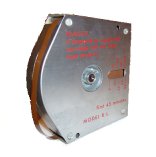| | We
know that these days, anybody with a turntable and a computer can put an album
onto a CD... and that's exactly why everybody does. But we are audiophiles and
engineers. Our LP remastering is used by record companies for CD release when
the master tapes are lost. Nobody will ever know that CD came from a record. And
we're certainly not going to tell. |
|
| RCA
found that 45 RPM was the optimal speed for a record, given groove speed, stylus
size, etc. In fact, some new audiophile albums are cut at 45 RPM. Unfortunately,
all that is for nought as most 45's are mastered very poorly. Some 45's are made
from styrene rather than vinyl. Such records, while restorable, have a compromised
sound quality. A special stylus is required for playback. |
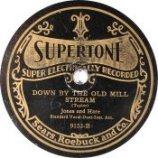 | There
are many flavors of 78 RPM records. The earliest were recorded without electricity,
with musicians playing into a large horn. When electric recording came along,
equalization became a factor, with about a half-dozen different EQ curves to follow.
Early acoustic 78's sound very limited, but by the 1950's, 78 recording was at
its peak, and some can sound surprisingly good. |
 |
Magnetic tape replaced
wire recording in the 1940's. Not only was it easier to work with, tape could
do one thing wire couldn't... record in stereo. Reels can be from 3" to 14",
with 7" and 10.5" the most common size. We can accomodate any reel,
any track arrangement, any size. We also do remastering for commercial CD releases. Some
tape stocks absorbed moisture into the binder, making the tape unplayable without
baking. We bake tapes at a slight additional charge. |
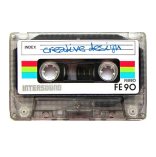 | In
the 1960's cassettes were introduced as a dictation format. In the 1970's tape
formulas and decks improved to the point of high fidelity, and became the standard
for home recordings. If well-recorded, they can sound great. Many "cheap"
cassettes arrive with separated leaders. We can repair such cassettes. |
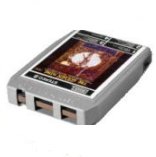 | 8-tracks
were a portable format derived from the cartridge that was used in radio broadcasting.
They were never developed into a high fidelity format, and (thankfully) died off
as cassettes became available. Once remastered, they don't sound too bad at all.
Every cartridge will need repair to become playable, as the splice falls apart
and the pressure pad has turned to goo. |
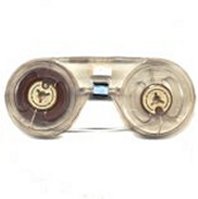 | Norelco
cartridges were introduced in the 1960's as a dictation format. They were never
able to supplant the belts they were envisioned to replace, as they were a bit
more cumbersome to use in an office. They were not incredibly popular, so you
won't see many of them. But they are recoverable and restorable with good sound
quality. |
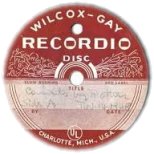 |
The mis-named "acetates"
(actually they are nitrocellulose) were offered by many manufactureres for home
recordings. They can range from little cardboard discs to 12" aluminum-based
records. They might also be steel or glass. They are usually pretty hardy, but
some might have wrinkling or separation due to shrinkage of the plasticizer. The
downfall of many such records is the leaching of the camphor, which leaves a white
coating of noise on the surface. Such discs are recoverable. |
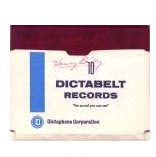 | "Visible"
Dictaphone belts (as opposed to magnetic belts, which you can't see through) were
the dominant force in office dictation after replacing cylinders and were used
in the 1950's and 1960's. Sometimes the belt information is written on the belt
itself with a grease pencil. The biggest problem with belts is that they shrink,
and therefore don't track properly on the playback mandrels, making playback problematic.
However, we can always recover them. Audio quality is usually good. |
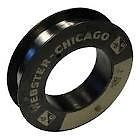 | Wire
recording was developed in the early 1900's as an offshoot of the telegraph. Although
functional, it did not attain good sound quality until the 1940's when vacuum
tubes came into play. The two main players were Webster and Armour, with their
systems incompatible with each other. We don't doubt that having a half-mile of
silver hair turn into stainless steel cotton candy gave rise to a whole new generation
of cuss words. |
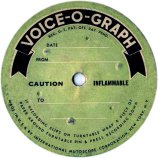 | Voice-O-Graphs
were popular in the 1940's and 1950's. They were made on machines that resembled
a telephone booth, and for 25 cents you could make a recording as a keepsake.
Since they are cardboard records, the recording medium shrinks and causes tiny
ridges to appear on the surface. Sometimes they become dish-shaped. Discs of this
type were used for novelty records, like from the top of the Empire state building.
They are usually recoverable. |
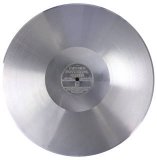 | Aluminum
discs were a very early home recording format, and were often used for radio station
logs. They did not cut the groove, but embossed it onto the surface. A special
needle was require for playback, and if you tried to play them on a Victrola,
it literally erased the recording. Sadly, a great many of these discs were the
victim of WWII scrap drives. |
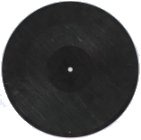 | The
very first home recording format was the Kodisk. This was a pre-grooved 78 with
a soft cutting medium. What you did was put on the disc, put the needle into the
groove, and scream as loudly as you could into the phonograph horn. Then, with
any luck, you had a small chance of hearing yourself. Unfortunately, the needle
was so heavy that the very act of playing it effectively erased it after two playings.
Thus, we have never seen a playable Kodisk. |
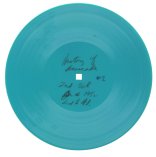 | Soundscribers
were a dictation format popular in the 1940's and 1950's. These discs were made
from a very sturdy material and most remain in playable condition today. Sound
quality is fair with an understandable voice, which is all one can ask from a
dictation format. They came in a variety of sizes up to 7". They were popular
for institutional recordings. |
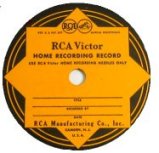 | RCA
made pre-grooved recording blanks in the 1930's. Because the groove was not cut,
but modulated at the very top, sound quality is quite atrocious, and a special
needle is require to play them. Frequency response is flat from 1,000 to 1,100
Hz. |

